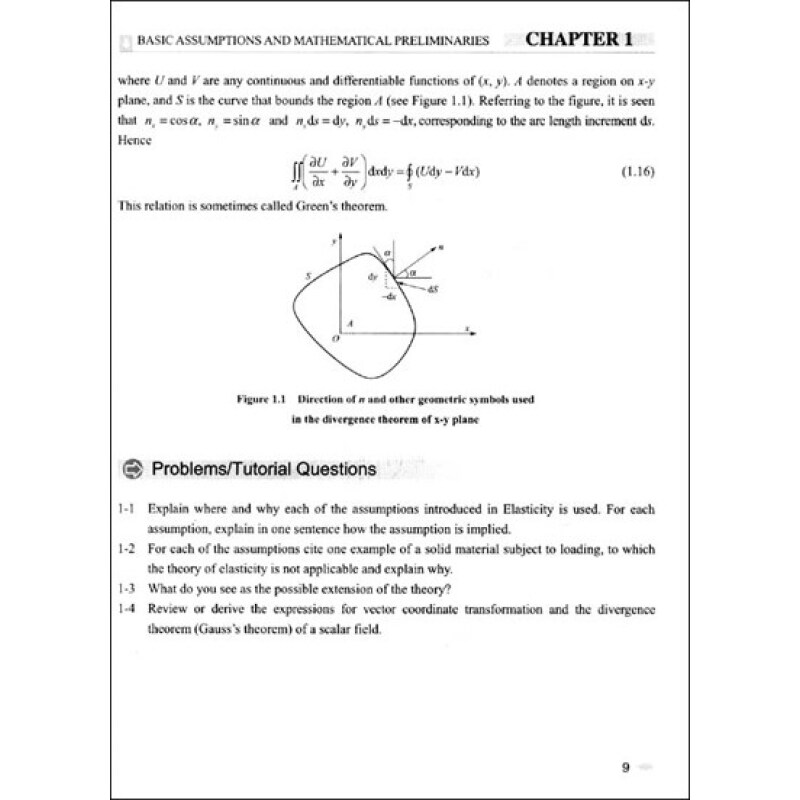Details
he purpose of this book is to introduce the basic knowledge about the classic elasticity theories and the associated research achievements by the authors. The whole book is constructed on the basis of the course syllabuses and the con-tents of elasticity used in the past few years at Beijing Institute of Technology, China and the University of Manchester,UK. In order to meet the requirement of bilingual pedagogic development in higher education, and with reference to some classic textbooks on elasticity and newly-obtained teaching and learning outputs, such a content arrangement of this book can currently be more appropriate and convenient for readers to study elasticity under the dual-language environment.
By reading this book as well as other relevant Chinese-version textbooks, the readers should be able to com-mand the fundamental knowledge of elasticity, comprehend some related standard technical terms and enhance their level of professional English. The book is intended for senior undergraduate and postgraduate engineering students,especially for engineering mechanics students, of higher education engineering institutes. It can also be consideredas an English reference for engineers, researchers and novices.
Table of Contents
CHAPTER 1 BASIC ASSUMPTIONS AND MATHEMATICAL PRELIMINARIES
1.1 Introduction
1.2 Basic Assumptions
1.3 Coordinate Systems and Transformations
1.4 Vector and Matrix Notations and Their Operations
1.5 Divergence Theorem
Problems/Tutorial Questions
CHAPTER 2 STRESSES
2.1 Stress and the Stress Tensor
2.2 Equilibrium Equations
2.3 Traction Boundary Conditions
2.4 Stresses on an Oblique Plane
2.5 Principal Stresses
2.6 Stationary and Octahedral Shear Stresses
2.7 Equilibrium Equations in Curvilinear Coordinates
Problems/Tutorial Questions
CHAPTER 3 STRAINS
3.1 Strains
3.2 Finite Deformations
3.3 Strains in a Given Direction and Principal Strains
3.4 Stationary Shear Strains
3.5 Compatibility
3.6 Kinematic and Compatibility Equations in Curvilinear Coordinates
3.7 Concluding Remarks
Problems/Tutorial Questions
CHAPTER 4 FORMULATION OF ELASTICITY PROBLEMS
4.1 Strain Energy Density Function
4.2 GeneralisedHooke's Law
4.3 Initial Stresses and Initial Strains
4.4 Governing Equations and Boundary Conditions
4.5 General Solution Techniques
4.6 St. Venant's Principle
Problems/Tutorial Questions
CHAPTER 5 TWO-DIMENSIONAL ELASTICITY
5.1 Plane Strain Problems
5.2 Plane Stress Problems
5.3 Similarities and Differences Between Plane Strain/Plane Stress Problems
5.4 Airy Stress Function and Polynomial Solutions
5.5 Polar Coordinates
5.6 Axisymmetric Stress Distributions
5.7 Rotating Discs
5.8 Stresses Around a Circular Hole in a Plate Subjected to Equal Biaxial Tension-Compression (Pure Shear in the 45° Direction)
5.9 Stress Concentration Around a Circular Hole in a Plate Subjected to Uniaxial Tension
5.10 Concluding Remarks
Problems/Tutorial Questions
CHAPTER 6 TORSION OF BARS
6.1 Torsion of Bars in Strength of Materials
6.2 Warping
6.3 Prandtl's Stress Function
6.4 Torque
6.5 Bars of Circular and Elliptical Cross-Sections
6.6 Thin-Walled Structures in Torsion
6.7 Analogies
Problems/Tutorial Questions
CHAPTER 7 BENDING OF BARS
7.1 Bending Theory in Strength of Materials
7.2 Elasticity Formulation of Bending of Bars
7.3 Stress Resultants and Shear Centre
7.4 Bending of a Bar of a Circular Cross-Section
7.5 Bending of a Bar of an Elliptical Cross-Section
7.6 Analogies
Problems/Tutorial Questions
CHAPTER 8 THE STATE SPACE METHOD OF 3D ELASTICITY
8.1 Concept of State and State Variables
8.2 Solution for a Linear Time-Invariant System
8.3 Calculation of e[A]t
8.4 Solution of Linear Time-Variant System
8.5 State Variable Equation of Elasticity
8.6 Application of State Space Method
8.7 Conclusions
Problems/Tutorial Questions
CHAPTER 9 BENDING OF PLATES
9.1 Love-KirchhoffHypotheses
9.2 The Displacement Fields
9.3 Strains and Generalised Strains
9.4 Bending Moments
9.5 The Governing Equation
9.6 Generalised Forces
9.7 Boundary Conditions
9.8 Rectangular Plates
9.9 Circular Plates
Problems/Tutorial Questions
CHAPTER 10 ENERGY PRINCIPLES
10.1 Introduction
10.2 Work, Strain Energy and Strain Complementary Energy
10.3 Principle of Virtual Work
10.4 Application of the Principle of Virtual Work
10.5 The Reciprocal Law of Betti
10.6 Principle of Minimum Potential Energy
10.7 Principle of Virtual Complementary Work
10.8 Principle of Minimum Complementary Energy
10.9 Castigliano's Theorems
10.10 Application of the Principles of Minimum Strain Energy
10.11 Rayleigh-Ritz Method
Problems/Tutorial Questions
CHAPTER 11 SPECIAL TOPICS FOR ELASTICITY
11.1 Thermal Elasticity
11.2 Propagation of Elastic Waves
11.3 Strength Theory, Crack and Fracture
Problems/Tutorial Questions
REFERENCES
Sample Pages Preview

